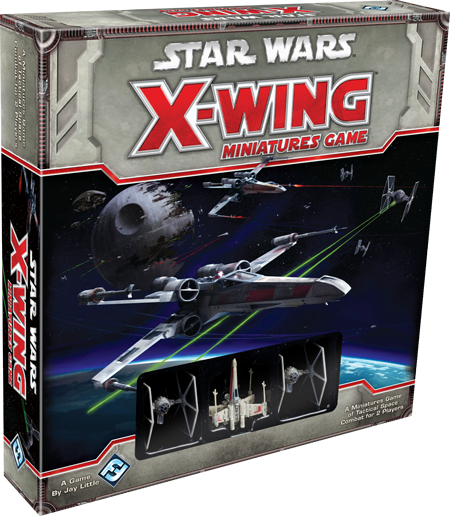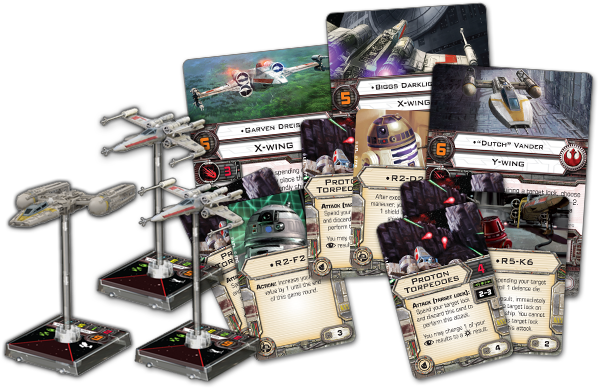En la tónica habitual de los últimos dias, FFG continua ofreciéndonos pildoras informativas, del que sera su nuevo juego de minis, ambientado en la recientemente adquirida licencia de Star Wars, X-Wing.
En esta ocasión, veremos como dependiendo de los puntos que tengamos, podremos construir nuestro escuadrón de forma más o menos efectiva.
Vamos a ver formaciones básicas de 100 puntos, o lo que viene a ser lo mismo, unas 4 naves más o menos.
“Several fighters have broken off from the main group. Come with me!”
–Darth Vader, Star Wars: A New Hope
–Darth Vader, Star Wars: A New Hope
Now that we’ve previewed the fast-paced combat of X-Wing™, as well as its first wave of starfighters, and rules, we can explore some of the more advanced strategies that open up when you begin building larger squads.
The play experience from the Core Set is rich enough to reward players with hours upon hours of entertainment. Still, tournament players and others will be interested in the greater design flexibility that larger squadrons afford them, and the game permits an astounding range of possibilities with just a few starfighters.
In fact, the official X-Wing dogfight tournament rules limit players to 100 squad points, and while that number may seem large at first, you may be surprised how quickly you have to make difficult choices to keep your squadron at 100 points or below.
Finding Balance

With the release of the Core Set, players are soon to discover that two squadrons that share the same number of squad points can differ vastly in their play style. The Core Set grants the Rebel player control of a single X-wing, but to oppose it, the Imperial player gains command of two TIE fighters.
As an example, the Imperial player might field both “Mauler Mithel” and an Academy Pilot for twenty-nine squad points. In turn, the Rebel player might spend the same twenty-nine squad points on a Rookie Pilot, R2-D2, and Proton Torpedoes. The Imperial player has an advantage in the number of actions his starfighters may take each turn, but the Rookie Pilot’s X-wing is the sturdier starfighter with both its deflector shields and an astromech that can repair damage to its shields each time it performs a green maneuver.
The differences magnify as the squad points increase, and each player has to find a suitable balance among the game’s starfighters, pilots, and upgrades. Can you get the maximum value out of a swarm designed to activate more ships than your opponent? Or is it easier for you to avoid a crowded battlefield, managing just a few ace pilots in starfighters decked out with powerful upgrades?
With 100 squad points, you’ll be able to fly a Rebel squadron of three to four fighters or an Imperial force with as many as eight TIE fighters or as few as three elite, outfitted TIE Advanced.
It’s also worth noting that when you play with squad building rules, the initiative goes to the player with the fewer squad points. This means that if your squadron is even just one point less than your opponent’s, when you and your opponent have ships with the same pilot skill, you activate yours first. Win the initiative, and your pilots get a better chance to shoot first!
Sample Squadrons
Of course, it’s one thing to talk about the differences between 100-point squadrons in the abstract and quite another thing to present examples. Without further ado, we present a few of the many possible 100-point squadrons you can build with a Core Set and just a couple single starfighter expansions.

Elite Rebels
(99 points)
(99 points)
“Dutch” Vander (23 points)
Proton Torpedoes (4 points)
Proton Torpedoes (4 points)
R5-K6 (2 points)
Proton Torpedoes (4 points)
Proton Torpedoes (4 points)
R5-K6 (2 points)
Biggs Darklighter (25 points)
Proton Torpedoes (4 points)
R2-D2 (4 points)
Proton Torpedoes (4 points)
R2-D2 (4 points)
Garven Dries (26 points)
Proton Torpedoes (4 points)
R2-F2 (3 points)
Proton Torpedoes (4 points)
R2-F2 (3 points)
This squadron seeks to take advantage of the Rebel Alliance’s superior firepower, and flies in formation to pick off enemies one by one. “Dutch” Vander grants his squadmates free Target Locks whenever he gains a Target Lock. R5-K6 gives him a chance of acquiring a new target lock immediately after spending his previously lock, which would grant a squadmate yet another Target Lock. While “Dutch” sets up volleys of proton torpedoes, Biggs Darklighterdraws fire by forcing opponents to shoot at him. The damage he takes to his shields he can then repair with R2-D2.

Imperial Swarm
(100 points)
(100 points)
Darth Vader (29 points)
Concussion Missiles (4 points)
Swarm Tactics (2 points)
Concussion Missiles (4 points)
Swarm Tactics (2 points)
“Mauler Mithel” (17 points)
Academy Pilot (12 points)
Academy Pilot (12 points)
Academy Pilot (12 points)
Academy Pilot (12 points)
Academy Pilot (12 points)
Academy Pilot (12 points)
Academy Pilot (12 points)
This squadron takes advantage of superior numbers to overwhelm the enemy. Darth Vader leads the attack with hard-hitting concussion missiles and the Swarm Tactics talent, which allows an adjacent Academy Pilot to attack early in the combat phase, as though it had a pilot skill of “9.” While the Academy Pilots have low pilot skill, their lasers hit as hard as those of any TIE fighter, and their sheer numbers are sure to strike fear into the hearts of the Rebels.

Elite Imperials
(99 points)
(99 points)
Darth Vader (29 points)
Concussion Missiles (4 points)
Squad Leader (2 points)
Concussion Missiles (4 points)
Squad Leader (2 points)
Maarek Stele (27 points)
Cluster Missiles (4 points)
Marksmanship (3 points)
Cluster Missiles (4 points)
Marksmanship (3 points)
“Mauler Mithel” (17 points)
Obsidian Squadron Pilot (13 points)
This elite Imperial squadron is all about bringing the hurt at close range. As Squad Leader, Darth Vader grants a nearby Maarek Stele the ability to use both the Target Lock and Marksmanship actions in the same turn, super-charging his Cluster Missiles and nearly guaranteeing that he’ll score and choose a devastating critical hit against whatever he targets. If Maarek ever goes down, Vader can lend his support to “Mauler Mithel,” who gets an extra attack die at close range.

Rebel Swarm
(100 points)
(100 points)
Rookie Pilot (21 points)
Proton Torpedoes (4 points)
Proton Torpedoes (4 points)
Rookie Pilot (21 points)
Proton Torpedoes (4 points)
Proton Torpedoes (4 points)
Rookie Pilot (21 points)
Proton Torpedoes (4 points)
Proton Torpedoes (4 points)
Rookie Pilot (21 points)
Proton Torpedoes (4 points)
Proton Torpedoes (4 points)
X-wings are among the most powerful fighters in the Star Wars universe, and this squadron serves as evidence. Rookie Pilots may not be the most exciting pilots, but they all know how to fire Proton Torpedoes. This squadron manages to assemble four X-wings and four sets of Proton Torpedoes. You’ll want to acquire Target Locks early, then use your shields to absorb the inevitable first volley, and retaliate in force with the X-wing’s superior firepower.
All Pilots to Your Ships
The fate of the galaxy will soon be decided in dramatic space combats. The time has come to take a side. Both Rebel and Imperial fleets stand in need of a few good commanders, so get ready to assemble your squad and join the fight…X-Wing debuts at Gen Con Indy later this week!


















0 comentarios :
Dí lo que piensas...